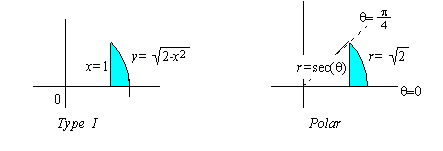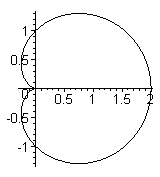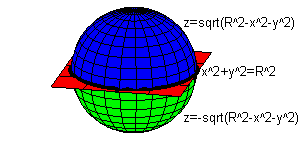Part 2: Areas and Volumes in Polar Coordinates
If R is a region in the xy-plane bounded by q = a,
q = b, r = g( q) , r = f( q) ,
then (1) implies that
|
Area of R = |
 |
dA = |
|
b
a
|
|
|
f( q)
g( q)
|
rdrdq |
|
thus allowing us to find areas in polar coordinates.
EXAMPLE 2 Find the area of the region between x = 1, x = Ö2, y = 0, and
Solution: Since x = 1 corresponds to rcos( q) = 1 or r = sec( q) , the region is between the line r = sec( q) and a circle of radius Ö2 from q = 0
to q = p/4:

Thus, the area of the region is
|
Area = |
 |
dA = |
|
p/4
0
|
|
|
Ö2
sec( q)
|
rdrdq |
|
and evaluation of the iterated integral leads to
|
|
|
|
|
|
p/4
0
|
|
r2
2
|
ê
ê
|
Ö2
sec( q)
|
dq |
| |
|
|
|
1
2
|
|
|
p/4
0
|
( 2-sec2( q) ) dq |
| |
|
|
|
1
2
|
( 2q-tan( q) ) |
ê
ê
|
p/4
0 |
| |
|
|
|
Moreover, we can use polar coordinates to find areas of regions
enclosed by graphs of polar functions.
EXAMPLE 3 What is the area of the region enclosed by the
cardioid r = 1+cos( q) , q in [ 0,2p] .

Solution: Since the cardioid contains the origin, the lower
boundary is r = 0. Thus, its area is
|
Area = |
|
2p
0
|
|
|
1+cos( q)
0
|
rdrdq = |
|
2p
0
|
|
r2
2
|
ê
ê
|
1+cos( q)
0
|
dq |
|
Substituting and expanding leads to
|
|
|
|
|
1
2
|
|
|
2p
0
|
[ 1+2cos( q)+cos2( q) ] dq |
| |
|
|
|
1
2
|
|
|
2p
0
|
|
é
ë
|
1+2cos( q) + |
1
2
|
+ |
1
2
|
cos( 2q) |
ù
û
|
dq |
| |
|
|
|
1
2
|
|
æ
è
|
|
3
2
|
q+2sin( q) + |
1
4
|
sin( 2q) |
ö
ø
|
ê
ê
|
2p
0
|
|
| |
|
|
|
Polar coordinates can also be used to compute volumes. For example, the
equation of a sphere of radius R centered at the origin is
Solving for z then yields shows us that the sphere can be considered the
solid between the graphs of the two functions
over the circle x2+y2 = R2 in the xy-plane.

Since circle x2+y2 = R2 defines the type I region
the volume of the sphere of radius R is given by the iterated integral
EXAMPLE 4 Use polar coordinates to evaluate
Solution: To begin with, we rewrite the iterated integral as a
double integral over the interior of the circle of radius R centered at
the origin, which is often denoted by D:
In polar coordinates, the disc D of radius R is bounded by the
curves q = 0, q = 2p, r = 0, r = R, so that
Thus, if we let u = R2-r2, then du = -2rdr, u( 0) = R2,
u( R) = 0, so that
|
|
|
| |
|
|
- |
|
2p
0
|
|
u3/2
3/2
|
ê
ê
|
0
R2
|
dq |
| |
|
| |
|
|
|
Check your Reading: What is the volume of the unit sphere?



